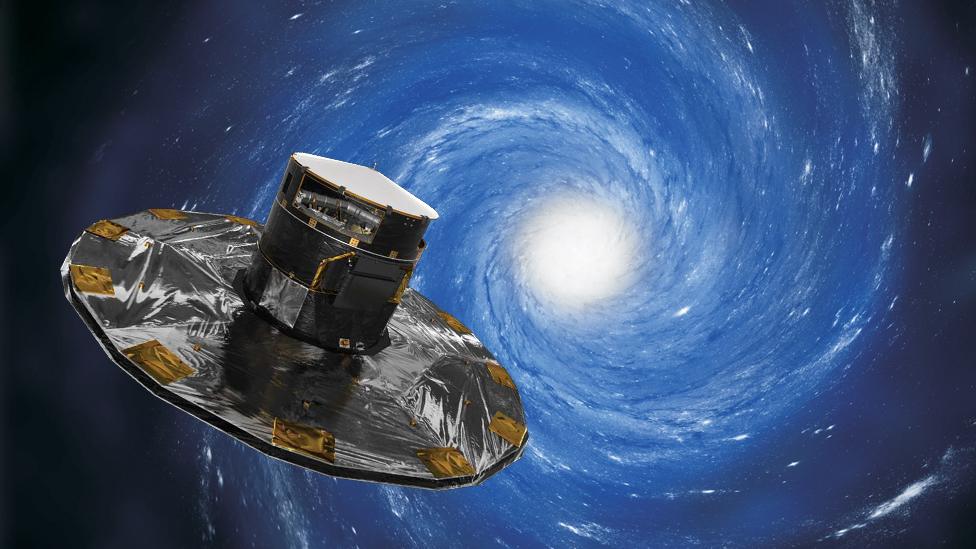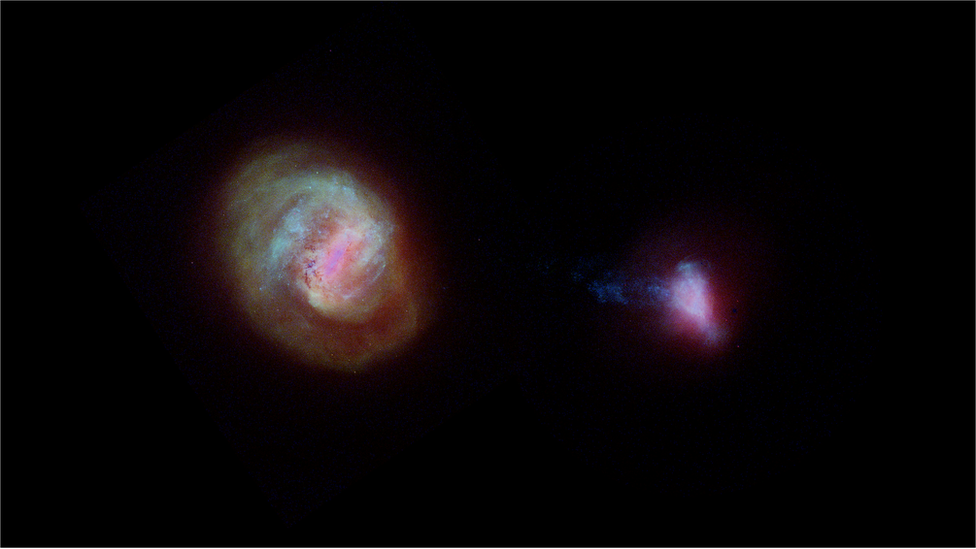Gaia 'discovery machine' updates star catalogue
- Published

Gaia data can predict how stars will move across the sky in the next 400 thousand years
It's been described as the "ultimate book of the heavens" - a catalogue of stars in our Milky Way Galaxy assembled by Europe's Gaia Space Telescope.
On Thursday, scientists gave an update on how its survey is progressing.
So far, Gaia has plotted the precise positions of more than 1.8 billion stars; and for most of these, it also knows their exact distance from Earth and their movement across the sky.
Launched in 2013, the telescope still has four years of work ahead of it.
But even now, this "discovery machine" is pumping out new insights on the cosmos at an incredible rate. Every day, something like three scholarly papers are published based on its data.
Nothing matches it for productivity, not even the mighty Hubble observatory.
"Gaia data is like a tsunami rolling through astrophysics," said Prof Martin Barstow from the University of Leicester, UK.
"It touches every part of astrophysics from nearby stars, planets in our Solar System, all the way through to the edge of the Universe. It's just transformational. You'll be talking about astronomy before Gaia, and after Gaia - and those two things will be completely unrecognisable when you compare them," he told BBC News.


As the Earth goes around the Sun, relatively nearby stars appear to move against the "fixed" stars that are even further away
Because we know the Sun-Earth distance, we can use the parallax angle to work out the distance to the target star
But such angles are very small - less than one arcsecond for the nearest stars, or 0.05% of the full Moon's diameter
Gaia will make repeat observations to reduce measurement errors down to seven micro-arcseconds for the very brightest stars
Parallaxes are used to anchor other, more indirect techniques on the 'ladder' deployed to measure the most far-flung distances

The European Space Agency's Gaia satellite looks like a spinning top hat, but it's an example of exquisite engineering.
Stationed a million miles from Earth, it records on its British-built camera everything that shines and everything that moves - and does it with astonishing precision.
This is especially important when trying to measure distances, which Gaia achieves by tracking how objects wobble ever so slightly on the sky as it circles the Sun.
It's a form of trigonometry (parallax), and over time the telescope is beating down the uncertainties in its assessments.
For a 15th magnitude star - which has a faintness far beyond naked-eye visibility - the error is now 0.027 milliarcseconds.
"That's equivalent to a pound coin viewed at around 200,000km," explained Dr Nicholas Rowell from the University of Edinburgh.

Artwork: Gaia will give us some fundamental insights on the nature of our Milky Way Galaxy
Scientists gave their first update on the status of the Gaia catalogue in 2016, just over two years after launch. By then, Gaia had clocked 1.1 billion light sources. By 2018, this had been raised to 1.6 billion. Thursday's update pushes up the number again.
For 1.8 billion light sources, the telescope knows the exact position and brightness. Of these, 1.5 billion have their distance and sideways movement recorded. And a similar number have their colours catalogued, which is important for knowing properties, such as temperature, composition and age.
For a small subset, about 7.2 million stars, Gaia has calculated their radial velocity - their movement towards or away from us. Some are ultra-speedy, moving in excess of 500km per second.
Such velocities mean these stars might have come from beyond the Milky Way, speculated Dr George Seabroke from the Mullard Space Science Laboratory.
"These are often halo stars - so stars that spend most of their time away from the galactic disc, and then you see them plunging through (the disc). Some of them could be interlopers. With a full analysis of them, we should be able to pin down their origin."

Gaia is providing new information also on the nearby dwarf galaxies - the Large and Small Magellanic Clouds
One of the most fascinating details released on Thursday concerns the gravitational acceleration exerted on the Sun by the mass of the Milky Way, ensuring our star and its planets stay in orbit around the galactic centre.
This was achieved by Gaia tracing its movement against the stars, using the "fixed" points of light from very far-away galaxies as a reference frame.
The acceleration is tiny. It deflects the path of our Solar System by only 115km per year - but that's enough to stop it shooting off across the cosmos.
"Just three years ago, there was a paper that stated this value would be far too small to measure. But, in fact, we can measure it, and by the end of the Gaia mission we should get to an accuracy of about 1%. That is beyond anything we could have imagined," Dr Floor van Leeuwen from the University of Cambridge told BBC News.

This is what 1.8 billion looks like - the total density of stars observed by Gaia
About half of the gravitational attraction holding the Sun in place comes from the visible matter in the Milky Way; the other half comes from the invisible mass - so-called "dark matter". Science has no idea what this is, other than it has influence on normal matter.
"The hope is that by continuing experiments along the lines that we're doing and making them more precise, and doing them on different scales, we'll be able to see if there are different types of dark matter," said Prof Gerry Gilmore, also from Cambridge.
"So these precision tests of the way mass is distributed and the way things are moving around are actually probing the limits of fundamental physics."
Gaia's life in space is limited by its store of nitrogen which it ejects through thrusters to maintain fine pointing. When this fuel reserve is exhausted, the mission will be shut down. The end date is projected to be 2024.
Long after it's gone, though, Gaia will be the definitive guide.
For decades to come, every telescope pointed at the heavens will be using its map, and every space probe sent out across the Solar System will be using that same chart for pinpoint navigation.
Jonathan.Amos-INTERNET@bbc.co.uk, external and follow me on Twitter: @BBCAmos, external